
 Franciscan
Presence, and Fr Ken Leech
Franciscan
Presence, and Fr Ken Leech
 In
1945, at the invitation of Fr John Groser, the Anglican Society of St
Francis (SSF)
moved into
the area, setting up a house at 84 Cable Street to be a 'praying
presence' and to offer ministry to vulnerable Asian and African
seamen who found themselves stranded and destitute. Local people
remember the archetypal Franciscan symbol of the Christmas crib
displayed each year in the front window. According to Ken Leech (see below, and article right in the Jewish Socialist
for Autumn 1987) next door at no.86 for a time were the world
headquarters of the 'Liberal Party of Malta' featuring statues of the
Sacred Heart and Our Lady and a picture of Jo Grimond, each with a votive lamp. Right, by way of contrast, is a painting of c1830 by Frederick Calvert of 84-96 Cable Street.
In
1945, at the invitation of Fr John Groser, the Anglican Society of St
Francis (SSF)
moved into
the area, setting up a house at 84 Cable Street to be a 'praying
presence' and to offer ministry to vulnerable Asian and African
seamen who found themselves stranded and destitute. Local people
remember the archetypal Franciscan symbol of the Christmas crib
displayed each year in the front window. According to Ken Leech (see below, and article right in the Jewish Socialist
for Autumn 1987) next door at no.86 for a time were the world
headquarters of the 'Liberal Party of Malta' featuring statues of the
Sacred Heart and Our Lady and a picture of Jo Grimond, each with a votive lamp. Right, by way of contrast, is a painting of c1830 by Frederick Calvert of 84-96 Cable Street.
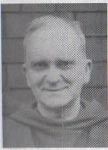
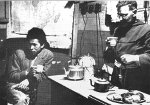 Before
the war the
West Indian and West African population of the East End was small, and
concentrated in Golding Street, Greenfield Street and Cable Street,
where Jewish landlords were prepared to rent them rooms. As more
settled in the area, few
of
the men,
and fewer of the women, spoke English. A small hostel and club was provided by Frs Charles (pictured - he also pioneered the Society's work in New Zealand - the Companions there paid the rent for Cable Street for a time: see here for his 1961 Church Times obituary) and Neville (who had
worked in India and was a good linguist) and a
succession of others.
At first this was geared to providing shelter and food for those in
work but with nowhere to live, but increasingly they became involved
with those who had mental health problems, and drug-users (the club was
closed on the first night the smell of ganja was detected - it was an
effective deterrent). Fr Neville officiated regularly at the church, including at some baptisms.
Before
the war the
West Indian and West African population of the East End was small, and
concentrated in Golding Street, Greenfield Street and Cable Street,
where Jewish landlords were prepared to rent them rooms. As more
settled in the area, few
of
the men,
and fewer of the women, spoke English. A small hostel and club was provided by Frs Charles (pictured - he also pioneered the Society's work in New Zealand - the Companions there paid the rent for Cable Street for a time: see here for his 1961 Church Times obituary) and Neville (who had
worked in India and was a good linguist) and a
succession of others.
At first this was geared to providing shelter and food for those in
work but with nowhere to live, but increasingly they became involved
with those who had mental health problems, and drug-users (the club was
closed on the first night the smell of ganja was detected - it was an
effective deterrent). Fr Neville officiated regularly at the church, including at some baptisms.
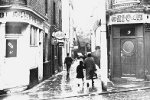
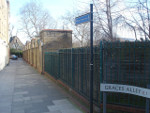 Cable Street became 'London’s Harlem' with a wild café culture that included Maltese, West Indian, Pakistani, Greek and Italian establishments - pictured is Grace's Alley in 1962, and today. From the 1950s Fr Joe Williamson at St Paul's
worked closely with the Franciscans,
providing accommodation in the basement of Church House Wellclose Square for an evening
school, which ran for seven years, three nights a week.The
Stepney Coloured People's Association was formed in 1951 (with Fr
Groser as its president) and its committee met at 84 Cable Street - see
Michael Banton The Coloured Quarter: Negro Immigrants in an English City (Jonathan Cape 1955) pp230-4. This was an era
of great tension over Commonwealth immigration, with many angry
meetings and demonstrations in the area; on the other side of London,
it led to the Notting
Hill race riots
in 1958. However, Ken Leech, in the article above, comments
that in his time on Cable Street (1958-67) local involvement in British
politics was notably absent.
Cable Street became 'London’s Harlem' with a wild café culture that included Maltese, West Indian, Pakistani, Greek and Italian establishments - pictured is Grace's Alley in 1962, and today. From the 1950s Fr Joe Williamson at St Paul's
worked closely with the Franciscans,
providing accommodation in the basement of Church House Wellclose Square for an evening
school, which ran for seven years, three nights a week.The
Stepney Coloured People's Association was formed in 1951 (with Fr
Groser as its president) and its committee met at 84 Cable Street - see
Michael Banton The Coloured Quarter: Negro Immigrants in an English City (Jonathan Cape 1955) pp230-4. This was an era
of great tension over Commonwealth immigration, with many angry
meetings and demonstrations in the area; on the other side of London,
it led to the Notting
Hill race riots
in 1958. However, Ken Leech, in the article above, comments
that in his time on Cable Street (1958-67) local involvement in British
politics was notably absent.
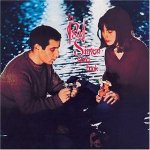
 One
regular visitor in the 1960s was a young American Jewish
singer-songwriter Paul Simon [left], who sang there from time to
time. He
and his English girlfriend Kathy Chitty lived at 6 Dellow House
(left, a
few yards from Shadwell
Overground station - see here for details of this building, and the likelihood that the opium den visited by Charles Dickens for his research on Edwin Drood stood on this site); it was the home of a German refugee Judith Piepe, who
loved folk music and often put up homeless musicians. (She was
involved with Ken Leech in setting up the homeless
charity
Centrepoint at St Anne's Soho.)
One
regular visitor in the 1960s was a young American Jewish
singer-songwriter Paul Simon [left], who sang there from time to
time. He
and his English girlfriend Kathy Chitty lived at 6 Dellow House
(left, a
few yards from Shadwell
Overground station - see here for details of this building, and the likelihood that the opium den visited by Charles Dickens for his research on Edwin Drood stood on this site); it was the home of a German refugee Judith Piepe, who
loved folk music and often put up homeless musicians. (She was
involved with Ken Leech in setting up the homeless
charity
Centrepoint at St Anne's Soho.)
In
1979, when 84 Cable Street was demolished, the Franciscans moved to
Toynbee Hall, and in 1982 to 10 Halcrow Street,
right by the Royal London Hospital. Other work developed –
including Sister Chris' ministry to deaf/blind people – and
local
parishes benefited in many ways from their involvement.
Their house has also been a base for lay people who are members of the Franciscan Third Order.
See further Petà Dunstan This Poor Sort - a history of the European Province of the Society of St Francis (DLT 1997) p140.
84
Cable Street proved to be a formative place for Ken
Leech, who wrote
| ...it was coming to the East End of London in 1958, as a student, which was the real turning point. I arrived at the time of the Notting Hill riots and came to live at 84 Cable Street. The East End seemed full of left-wing Christians - Stanley Evans, John Groser and others - and co-operation between Christians and Marxists was common. I got to know some of the old Communist councillors - Solly Kaye, Phil Piratin, Max Levitas [pictured here] - all of them atheists, but all of them having a long history of cooperation with socialist Christians with whom they had a lot in common. The East End has shaped me more than any place. Much of my time here, since 1958, has been involved with fighting fascism, working for decent housing, trying to create communities of resistance and solidarity. |
After four years here, as a 23-year old student at St Stephen's House, Oxford, Ken Leech wrote a short paper A Christian Mission for West Stepney [text here] which was published by Fr Joe Williamson (one of Ken's inspirers) and sent to the Bishops of London and Stepney, and other clergy and lay people in January 1963. (He had hoped to return to the area as a curate, but instead went to Hoxton.) Although, as he has admitted, the language is dated and some of the assumptions he made now seem patronising and questionable, it is remarkable in setting out a vision of collaborative working between the parishes of this area which anticipates by 41 years the proposals for the creation of a local Mission Action Zone [see here].
Though
proud of his roots in the Greater Manchester area (he was born in Dukinfield,
and retired to Mossley) Ken served most of his ministry in the East End
- with a spell in the West End (after his incumbency of St Matthew
Bethnal Green) at St Anne Soho (where he co-founded Centrepoint, a
youth homelessness project, and wrote knowledgeably and helpfully about
the drug scene), at Church House Westminster as a national adviser on
racism, and founder of the Runnymede Trust,
and as a spiritual guide to King's ordinands at St Augustine's College
Canterbury. His final London role was as 'community theologian' (a term
he invented himself - it was not a paid post) based at St Botolph
Aldgate, living in a scruffy flat overlooking Altab Ali Park (which was
the site of the original White Chapel that gave the area its name): Doing Theology in Altab Ali Park was
the title of one of his many books [listed in his Wikipedia entry],
which brought together prophetic social and political action - always
with a strong autobiographical slant - and spirituality, including
'minor classics' on prayer, and spiritual direction. Those who did not
know him could not understand how these were the work of the same hand,
but they all reflect his passionate commitment to 'subversive
orthodoxy' (with an anglo-Catholic flavour - in later life he was very
critical of newer 'secularising' and 'religion-lite' traditions). Prayer and Prophecy
is the apt title of extracts from his writings made by two of his
friends, via the Contextual Theology Centre (as it then was) at the Royal Foundation of St Katharine (now the Centre for Theology and Community, based in the crypt at St George-in-the-East: see also our 'new' website.) With Rowan Williams, he founded the Jubilee Group,
a network of Christian Socialists (most but not all of the Catholic
tradition), and on his website attempted to chronicle the various and
complex groupings and splits within this movement (the Labour Party has
nothing on all of this). Other pages on this site reference this
tradition.
In retirement, he suffered a stroke during surgery in 2011, from which he made a painfully slow recovery, but enablied him to keep in touch with his many friends, by phone and letter, and make a few trips. (He had previously made connections in the USA, particularly with Carolina, and tried to introduce to British audiences the pastoral theologian Urban T. Holmes III - of whom few had heard - though Michael Ramsey had, and Ken would tell how the former archbishop, in characteristic fashion, mused on his name - the Third ... yes, the Third ...) On 13 June 2014, aged 74, Ken celebrated the golden jubilee of his ordination at Holy Innocents, Fallowfield, with a few folk from Tower Hamlets present; he died, at Laurel Court, Withington in south Manchester, on 12 September 2015 (where the webmaster of this site, now retired to Greater Manchester, visited him earlier that day - one of many who paid homage during his last days), and his requiem was held at St Chrysostom's church, with burial the following day at Mossley Cemetery. We honour the memory of a great man, and pray for his wife Julie, and his son Carl (from a previous marriage). Full, generous and generally accurate obituaries have appeared in several papers, including the Telegraph, Guardian, Independent and Church Times (see also this piece from 2006).